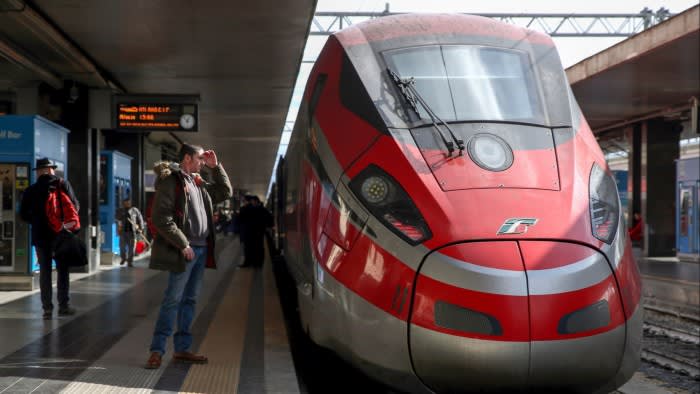Unlock the Editor’s Digest for free
Roula Khalaf, Editor of the FT, selects her favourite stories in this weekly newsletter.
Since the 2008 launch of the high-speed rail network between Rome and Milan, trains have become the preferred means of travel across Italy for locals and tourists alike.
Fast trains can cover the 500km between the two cities in three hours. The network also connects Naples, Bologna, Florence and Turin. In many cases, it is the best option — in terms of travel time and cost — for both leisure and business travellers.
This is why the recent severe delays caused by numerous maintenance works have thrown the rail industry into chaos at a time when most people head on holiday, which matters for business in a country where tourism accounts for 10 per cent of GDP.
Disruptions have become increasingly frequent with train delays becoming a constant fixture in Italian media coverage. In November, agriculture minister Francesco Lollobrigida sparked outrage when he was granted an unplanned stop to get off of a 110 minute-late train that, he claimed, would have otherwise caused him to miss an official engagement near Naples. Ferrovie dello Stato Italiane, the publicly controlled group that owns train operator Trenitalia and the national train network RFI, said that 23 per cent of all high-speed trains it operates were late in 2023.
The group said the situation had improved slightly in the first half of this year. Still, if personal experience is anything to go by, only two Trenitalia trains — both high-speed and not — out of the 12 I travelled on in July arrived on time. The others were all more than 30 minutes late. In one case, I was stranded for four hours at night near the coastal city of Ancona.
Newly installed chief executive Stefano Donnarumma confirmed there were issues. “Network interventions, inevitably, cause inconveniences, but if the interventions were to be postponed, the disruption could be significantly greater,” he said.
The huge improvements in Italy’s obsolete infrastructure partly explained the disruption, said Ferrovie. RFI, the network operator, is the single largest European recovery fund beneficiary with planned investments of €24bn by 2026. Ferrovie will invest a total of €124bn in infrastructure over the next 10 years.
But lack of capacity is another problem. Transport economist Andrea Giuricin said the planned investments would bring improvements but disruptions in the meantime were inevitable. The fact that Italy has as many as 377 high-speed trains scheduled per day does not help.
“We have a mixed system, there is no spare capacity and as soon as there’s a hiccup on the line, the situation becomes highly complex,” he said.
A mixed system means that high-speed trains must travel on the regular tracks on certain routes or when passing through large cities (except for Bologna which has an underground link). If there’s congestion or, for example, a local train breaks down, the entire high-speed network is affected.
One of the most important changes the upgrades will bring is the segregation of the high-speed line from the regular one — as is the norm in Spain or Japan — in certain urban centres, or “nodes”, through the construction of underground rail links. The next underground rail link expected to be completed is in Florence, but not until 2028.
Another issue is that Italy has a meagre 1,000km of high-speed rail tracks — mainly between Turin and Salerno, south of Naples — which compares with France’s 2,800km and Spain’s 3,200km. High-speed trains travelling further south, east to Venice or down the Adriatic coast, will have only limited access to the high-speed network.
While there are no amelioration prospects on the Adriatic line, planned EU recovery fund investments envisage the extension of the high-speed network from Lombardy to Venice and between Naples and Bari.
Improvements will also come from the high-density technology and satellite signalling that RFI has been investing in — a European first — for years, say experts. It will allow for a reduction of the distance between high-speed trains travelling on the same line at any given time, which should mean a significant increase in capacity and traffic fluidity, according to Giuricin.
The risk, however, is that the pace of the planned improvements is too slow to mitigate the negative impact on travel and customer satisfaction. That might be a problem for a country banking on tourism to help boost economic growth and bring down its large public debt.


